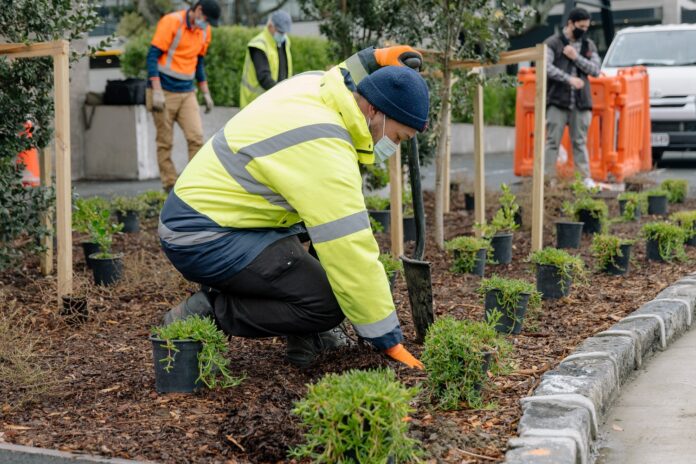Source: Auckland Council
Te Maharatanga o Ngā Wai.
Remembering our waters.
While many of the natural waterways which once flowed through Auckland’s city centre have been lost from sight – channelled, piped and progressively covered over – a new Māori design kaupapa, developed in an innovative partnership between Ngāti Whatua Ōrākei and Te Kaunihera o Tāmaki Makaurau / Auckland Council, will see those urban waters remembered.
In the coming weeks, when city centre residents and visitors wander down Sale Street and reach Wellesley Street, they will see this new public space taking shape. As all the elements come together, they will discover it carries meaning that is more than it seems.
[embedded content]
The project, enabled by Auckland Council’s City Centre Targeted Rate and Māori Outcomes funding, is set to bring a unique and thought-provoking public place design to the area.
The process adopted through this partnership has provided a unique education, mentoring and collaboration platform for two young Māori kaitiaki from Ngāti Whatua Ōrākei and Auckland Council’s Māori Design intern.
The three young men who have delivered this work, alongside the Te Kaunihera project team and under the guidance of Māori landscape architect Alan Titchener (Kai Tahu), are: Jyde Tamaariki (Ngāti Whātua Ōrākei), kaitiaki rakau; Etienne Neho (Ngāti Whātua Ōrākei), kaitiaki rakau; and Kahurangi Eruera (Te Tai Tokerau/Te Tairāwhiti), council’s Māori Design intern currently studying his Master of Architecture.
The initiative is called Te Maharatanga o Ngā Wai, remembering our waters.
Dane Tumahai of Ngāti Whātua Ōrākei says: “As ahikaa and in the spirit of our tupuna Apihai Te Kawau we continue to foster manaakitanga and seek nuture the growth of our rangatahi that sees our cultural identity reflected in the whenua and moana. ‘Kakahuria nga tangata, Kakahuria te Taiao’. Adorn the people so they can adorn the environment.”
Councillor Pippa Coom says Te Kaunihera o Tāmaki Makaurau / Auckland Council sees its main role in this project as empowering others.
“We are seeing inspiring leadership from the young people who are delivering this project. I suspect Te Maharatanga o Ngā Wai will become a benchmark way of working as we seek to bring uniquely Tāmaki Makaurau design to the city. It is exemplary placemaking,” she says.
Six elements are evident in the design: reo (language), whakatā (rest and relaxation), taiao (natural environment), tūrama (lighting), mahi toi (art) and whakamārama / ako (explanation, teaching and learning).
Phil Wihongi, Māori Design Lead of the Urban Design Unit at Te Kaunihera o Tāmaki Makaurau says: “All of these elements have been designed to remind us of these lost streams, and to prompt us to consider the place of nature and natural systems in the design of our urban environments.”
The work will begin with the planting of an understory of greenery beneath pōhutukawa. The plants have been grown in the Ngāti Whatua Ōrākei nursery, selected by the designers, and brought to the site for planting.
Four concrete seats have been 3D-printed off-site demonstrating the potential of this new technology. Each of the seats will contain around 40 repurposed car tyres, minimising the use of concrete and diverting the waste rubber away from landfill.
The curved organic shape of these tūru / benches draws inspiration from the lost stream’s natural form and the life that would have flourished in this place, in particular tuna (eels).
Later in November before an official opening, laser-cut corten steel pourama (light columns) will be installed. Lighting will spill through the openings, casting words of te reo onto the pavements with themes of kapua (cloud), ua (rain), awa (river), moana (sea) and an overarching message: oranga wai, oranga tāngata (healthy waters, healthy people).
The plan is for the safety cordons and construction wraps to come down ready for an official opening in late November (pandemic permitting).
It will mark the beginning of a journey of ako / teaching and learning for Aucklanders, with whakamārama / explanation on-site, about the waters that flow beneath our city.



